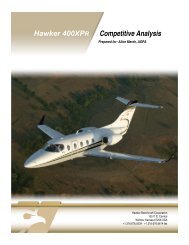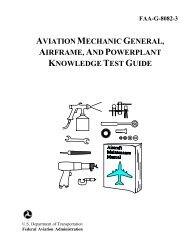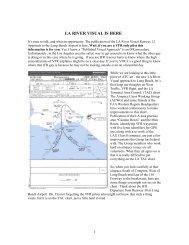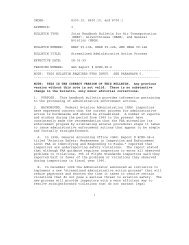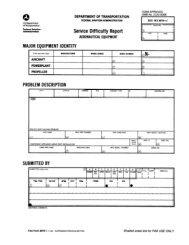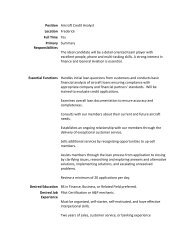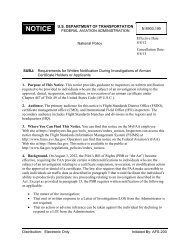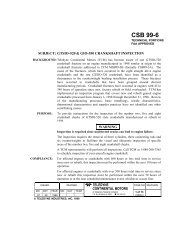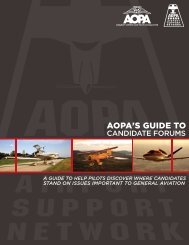2008 Nall Report - Aircraft Owners and Pilots Association
2008 Nall Report - Aircraft Owners and Pilots Association
2008 Nall Report - Aircraft Owners and Pilots Association
Create successful ePaper yourself
Turn your PDF publications into a flip-book with our unique Google optimized e-Paper software.
ACCIDENT FACTORS: FLIGHT PLANNING AND DECISION MAKING<br />
In other ways, fuel-management accidents are fairly<br />
typical of GA accidents in general, involving about<br />
the same proportions of private, commercial, <strong>and</strong><br />
airline transport pilots. Student pilots were only<br />
involved in two. Eighty percent (72 of 90), including<br />
seven of the nine fatal accidents, occurred on personal<br />
flights. Instructional flights only accounted for<br />
three, none fatal. Ten (including one fatal) were on<br />
other types of working flights, with the rest involving<br />
three positioning <strong>and</strong> two business flights. One of<br />
the latter was also fatal.<br />
Nearly nine-tenths (88 percent), including seven of<br />
the nine that were fatal, occurred in daytime. Fuelexhaustion<br />
accidents in IMC were rare, but those<br />
that occurred in IMC or at night were more apt to<br />
prove fatal (3 of 13 compared to 6 of 77 in daytime<br />
VMC).<br />
Weather<br />
50 total/41 fatal<br />
Typical weather accidents occur for one or more of<br />
the following reasons:<br />
• Continued VFR into IMC – These accidents<br />
often result in loss of aircraft control, or collision<br />
with the ground (CFIT) as the flight is continued<br />
into deteriorating ceilings <strong>and</strong> visibilities.<br />
• Deficient IFR Technique – Failure to follow appropriate<br />
instrument flight procedures, including<br />
descending below the minimum altitudes during an<br />
instrument approach.<br />
• Thunderstorm – Flying too close to, or penetrating,<br />
a thunderstorm. High winds, turbulence,<br />
<strong>and</strong> icing can result in structural failure <strong>and</strong> loss<br />
of control.<br />
• Turbulence – Turbulence associated with high<br />
winds, mountainous terrain, <strong>and</strong> other factors can<br />
result in loss of aircraft control.<br />
• Icing – Accumulation of ice on the airframe<br />
can lead to loss of lift <strong>and</strong> performance, as well as<br />
possible instrument malfunction due to iced-over<br />
sensors.<br />
Accident Case Study<br />
CHI08LA006<br />
Piper PA-28, Festus, Missouri<br />
One fatality<br />
History of Flight<br />
The airplane impacted trees while reportedly en route to the<br />
destination airport located approximately 1.5 miles from the<br />
accident site. The wooded area was adjacent to a clearing <strong>and</strong><br />
pasture. Examination of the wreckage revealed the left wing<br />
fuel tank was empty <strong>and</strong> the right wing fuel tank contained<br />
approximately one cup of water <strong>and</strong> one quart of aviation fuel.<br />
The right wing fuel line contained approximately one teaspoon<br />
of water <strong>and</strong> one teaspoon of aviation fuel. The electric fuel<br />
pump <strong>and</strong> gascolator contained water. There was no liquid in<br />
the carburetor bowl. The engine operated with no anomalies<br />
that would have precluded normal operation during a post accident<br />
engine run. The airplane flaps were in the fully retracted<br />
position <strong>and</strong> not in the extended position as would have been<br />
appropriate for a forced l<strong>and</strong>ing.<br />
Pilot Information<br />
The VFR-only private pilot, age 46, had 327 hours of total flight<br />
experience, with 54 hours in the accident make <strong>and</strong> model during<br />
the preceding 90 days.<br />
Weather<br />
Conditions were reported as night VFR (just before dawn) with<br />
clear skies, visibility 7 statute miles, <strong>and</strong> winds from 170 degrees<br />
at 3 knots.<br />
Probable Cause<br />
The pilot’s inadequate aircraft preflight, fuel system water<br />
contamination, <strong>and</strong> fuel starvation, which resulted in a loss of<br />
engine power during l<strong>and</strong>ing approach. An additional cause was<br />
the pilot’s failure to follow the emergency l<strong>and</strong>ing procedure after<br />
the loss of engine power. Contributing to the accident were<br />
the trees, <strong>and</strong> night light conditions.<br />
ASF Comments<br />
This pilot failed to perform the basic planning <strong>and</strong> preflight<br />
functions that every student pilot is taught. Determining fuel<br />
requirements that include an adequate reserve <strong>and</strong> making<br />
sure the fuel is free of contamination are critical.<br />
15



